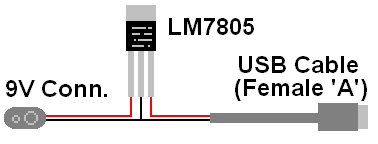I've commented elsewhere about the silliness of carrying a bunch of single-tasker chargers while going traveling, considering that most devices could be designed to charge using USB. In fact, my rule for techno-payload is:
- it's got to charge by USB, or
- it's got to be powered by AA batteries (since I only carry NiMH AA's and a charger.)
Happily, more and more manufacturers—the smart ones in my view—are making their devices rechargable using a USB cord. In fact, it has become a purchase requirement for me: being forced to carry a brick-on-a-string to use the device is a deal breaker; I won't buy it.
Given that there are a bunch of USB-chargable gadgets out there, here's a thought: a USB External Battery. Basically, it makes your USB-charged device think that it's plugged in, even though you're nowhere near a plug.
I spent some time googling, and only found one manufacturer of such a thing (so far.) It's a box the size of a pack of cigarettes containing a lithium-ion battery and a USB connector: just the right size for travel. Cool. Sixty bucks. Less cool.
Turns out, there's a really simple—and inexpensive—solution, one you can make yourself. With a nod to Jason Striegel's Hack-a-Day submission, I'll show you how. Basically, think a short cable with a USB connector on one end, a 9 volt connector on the other, and a bit of magic in between.
In this case, the magic is a mass-produced chip called the LM7805. It's a voltage regulator. Give it anywhere between 9 to 12 volts, and it converts that to a steady 5 volts... precisely what a USB device expects.
You can make such a cable for about five to 12 dollars in parts (depending on where you shop) plus an hour of your time.
Clockwise from top-right: The finished product shows a short piece of USB cable spliced to the 9 volt connector and an LM7805 chip; the splice and the chip are encased in hot-glue. Beneath that are another 9 volt connector and a spare LM7805 chip. At top-left is the battery pack holding 6 AA's to generate 9 volts.
With this converter cable, you can connect any 9 volt battery—small and compact as they are—and you'll get hours of use out of your portable device, without ever drawing down that device's internal battery. Even better, (and more to my liking,) you can buy a 6-AA pack that "pretends" to be a 9-volt battery (as far as connection type and voltage output go,) with the advantage of being rechargable. (No tossing a bunch of 9 volt batteries in the landfill, which is now against the law in California!) A few hours in the charger, and the AA's are ready for the next international flight. Works for me.

Assembly is straight-forward. I just got my hands on a cheap USB extender cable (female on one end, male on the other) which I cut in half to use the female end. The 9v connector's positive (red) wire was soldered to the LM7805's left (input) lead and the negative (black) wire was soldered to the LM7805's middle (ground) lead. The USB cable's pin 1 (red wire in my case, may be different for your cable) was soldered to the LM7805's right (output) lead, and the pin 4 (black in my case) wire was soldered onto the middle (ground) lead, too.
That's it. If you've got a volt-meter, you should measure around 5 volts between pins 1 and 4 of the USB connector when you have a 9v source on the other end.
In my case, I encased the splice and the chip in a gob of hot glue for strength and protection. Inexpensive and quick, though making some sort of a box isn't out of the question down the road. Plugging in my phone shows the charging icon, as does my Archos Gmini( which is really what I built this for.)
While it's easy to make, I guess that most people would rather buy one. Hopefully somebody will make these commercially available, for a price that's reasonable. In the meantime, here's all that it takes.
| USB Extender cable | $2.95 |
| LM7805 | .69 |
| 9v Connector | .55 |
| 6-AA Pack | 2.95 |
I got much of my stuff at a nearby "Halted Computer Specialties" store, but I think Radio Shack carries these parts, too, though no promises about the price.




 Generate a QR code link to this page
Generate a QR code link to this page